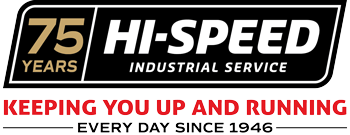Thanks to redundant engineering, today’s overhead crane systems are substantially easier and safer to operate than their counterparts from just twenty-years ago. However, utilizing the latest technology, redundant fail-safe systems, and OSHA safety standards can create a false sense of security for many companies and overhead crane operators.
To help maintain a safety-first focus during all overhead crane operations, we’ve assembled the top 6 potentially dangerous, and commonly overlooked overhead crane safety tips. The benefit to educating new and seasoned operators, and company owners to these common misconceptions is two-fold:
Benefit #1. Improve operator safety while minimizing potential accidents.
Benefit #2. Improve equipment longevity through proper use and maintenance.
Overhead Crane Safety Tip #1 – Regular Inspections
Common Misconception: The overhead crane worked flawlessly yesterday, so it’s safe to assume it will do the same today.
Reality: Despite being one of the simplest and most cost-effective overhead crane safety measures, only a small percentage of companies invest the 1-5 minutes needed each day for an inspection. While OSHA requires daily overhead crane inspections, there is no standardized checklist or reporting form required.
The best inspection can be divided into three parts and is easily tracked using a spreadsheet, word processing document, or job management software.
- Look – perform a visual inspection of the overhead crane and surrounding area for any potential hazards. Check for any damaged or broken parts and signs of a collision. Visually scan the cables for any cuts or fraying and check all rollers and pivots for binding or other damage.
- Listen – As you start up the crane are there any unusual or strange sounds? Are the upper and lower limit switches functioning? Check the trolley and bridge for excessive movement, and check all buttons and switches are functioning correctly.
- Document – complete a daily inspection report using a consistent checklist for the specific machinery. Ensure that the maintenance team or a supervisor receive your report, and then follow through that any repairs have been completed successfully.
Overhead Crane Safety Tip #2 – Secondary Braking System
Common Misconception: I can work underneath a suspended load with no risk because of the secondary brake requirements for all overhead cranes.
Reality: While it’s true that most overhead cranes feature a secondary brake system, this practice is extremely dangerous. Most primary brake systems utilize a fail-safe disc or drum brake which will hold the load in the event of a power loss.
Secondary brakes typically fall into one of two categories: mechanical or regenerative.
- Mechanical overhead crane brakes will hold the load if the primary brake fails. However, this option produces a lot of heat, and shouldn’t be used on loads over 30 tons, or for high usage applications of any size.
- Regenerative overhead crane brakes will not hold the load should the primary brake fail, instead they will lower the load to the ground at normal operating speed. Nearly 80% of secondary brakes are regenerative due to lower manufacturing costs and easier maintenance.
Never stand under a loaded overhead crane. Whether the load is free-falling, or lowering at normal speed, the operator could sustain sever injury or death.
Overhead Crane Safety Tip #3 – Reverse Plugging for Speed Control
Common Misconception: As the overhead crane travels in one direction, I can use reverse to slow down the load speed.
Reality: Back in the old days, overhead crane motors and contacts were much larger and heavier, and could stand the abuse and extra heat from the constant reversing to slow a load.
With today’s overhead cranes, the reverse button can remain locked until the load comes to a complete stop. As a result, reverse plugging is mostly no longer an option or accepted practice. And new inverter-controlled hoists feature a deceleration ramp. Like driving a car, you must slow down before you can stop, and you must accelerate to reach top speed.
Overhead Crane Safety Tip #4 – Upper Limit Switch
Common Misconception: To get the height I need; I should run the hoist until I hit the upper limit switch.
Reality: The upper limit switch on a overhead crane is a safety device, not an operational device. Should the upper switch limit fail, the hook and block will collide, potentially causing the steel cable to fail and dropping the load.
To create an operational limit switch, install a secondary switch wired in a fail-safe mode. In this scenario, contact with the upper limit switch will turn the hoist off. If fail-safe wiring isn’t used, the operator will not know the first switch has failed until the second switch also fails and potentially drops the load.
Overhead Crane Safety Tip #5 – Eliminating Side Pull
Common Misconception: If the overhead crane has enough steel cable or rope, I can grab a small load from the adjoining storage bay without any problem.
Reality: According to both the Hoist Manufacturers Institute and the Crane Manufacturers Association of America, hoists and cranes are designed to lift straight up and lower straight down.
Side pull is detrimental as the rope or cable can slip out its grooves and “scrubs” the rope or wire cable against adjoining surfaces or edges. The cable can also “jump the drum” and get tangled around the shafts of the block-and-tackle or other pulleys. Both scenarios can result in overstressing and potential cable/rope failure.
Side pulling is also dangerous for the overhead crane structure. Lifting with the cable at a 45 degree angle equalizes the lateral and vertical pressures and lead to a beam failure at just 50% of the crane’s rated capacity.
Overhead Crane Safety Tip #6 – Crane Overload
Common Misconception: Due to the safety factors incorporated by the manufacturer, overloading is not a real safety concern for me as an operator.
Reality: Probably the most common overlooked overhead crane safety tip we’ll discuss today. While some parts of the overhead crane include built-in safety features, this is not a blanket statement for the entire crane assembly.
For example, overhead cranes are typically attached to the building structure. So unless the building is built with the same safety factors, overloading can cause serious damage to your building, while putting operators in a very unsafe working environment.
Additionally, not all hoists come equipped with an overload protection system. Since 1974, all chain hoists require one, while wire rope hoists remain excluded from this requirement. Since most people can’t recognize what 20 tons looks like, an overload device can provide low-cost insurance for a potentially deadly mistake.
These six misconceptions are responsible for most overhead crane accidents, and unexpected component failure. Educating your employees and operators can minimize downtime while reducing maintenance costs and creating a safer environment for everyone.
Should you have any questions regarding overhead crane safety, maintenance, or repairs the Hi-Speed team has the answers you need. Simply call or send us an email today.

